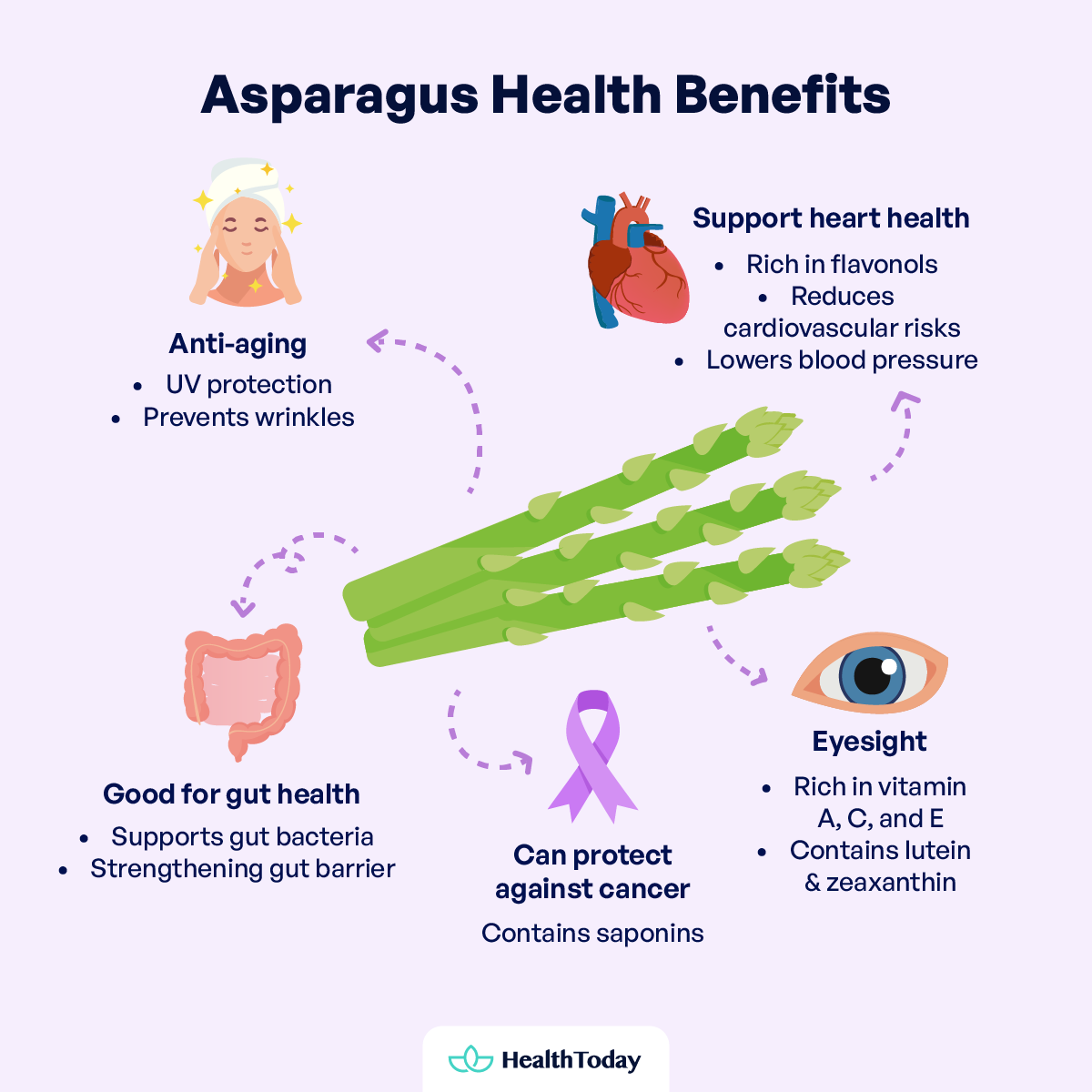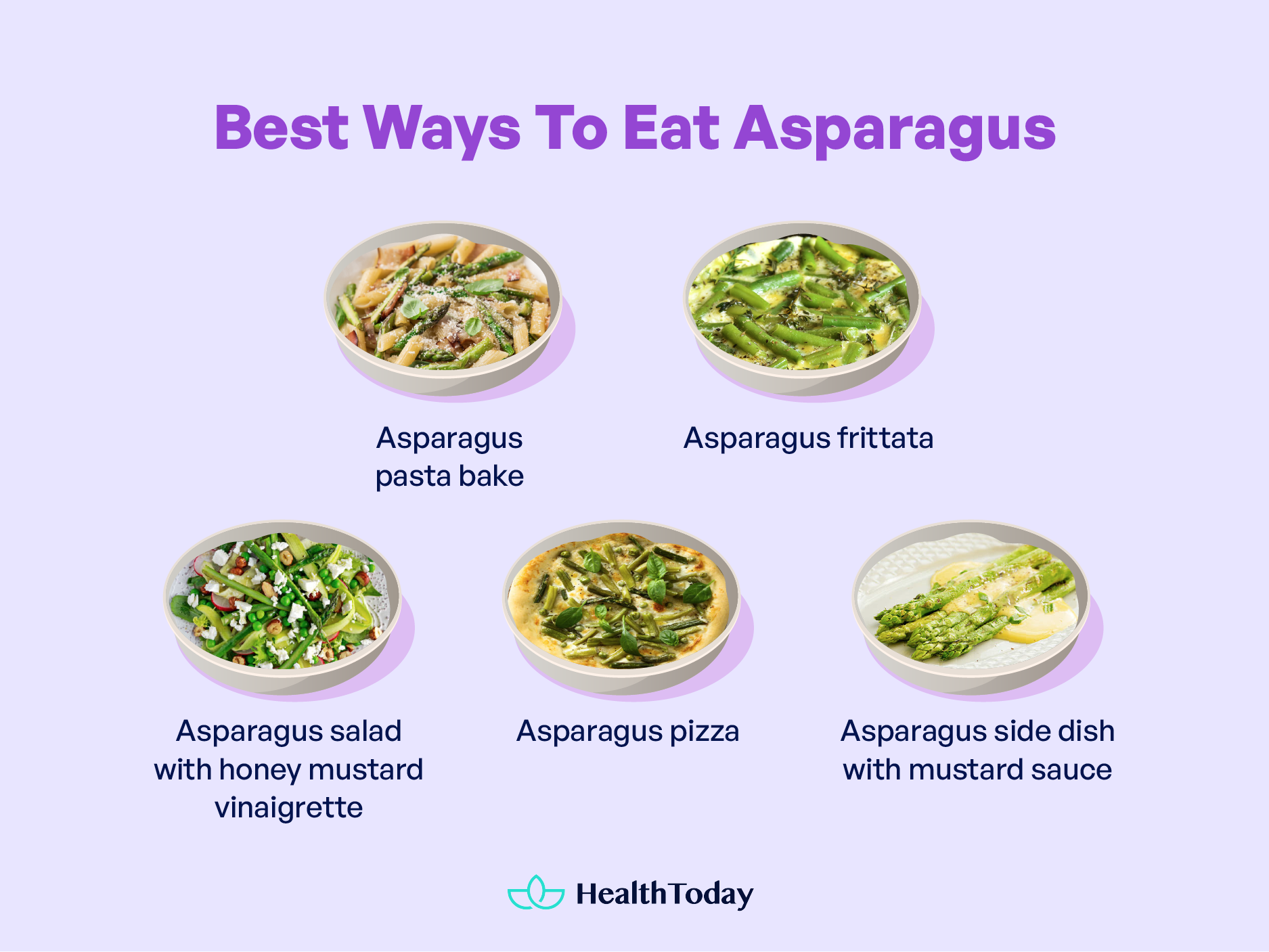Table of Contents
We all know that as a type of vegetable, asparagus is healthy. But what’s less known is that this popular veggie has anti-aging properties as well. In fact, it’s loaded with beneficial nutrients that can make your skin happy and glowing.
So, how exactly can it nurture your glamor? Are there other health benefits you might not be aware of? Is it beneficial for people with diabetes? Let’s keep reading to find out.
Stay tuned as we’ll also be sharing fantastic ways to prepare these speared delights with you.
Asparagus benefits for skin: May protect against skin aging
Ultraviolet (UV) radiation causes inflammation in skin cells, which can increase the rate of collagen loss and lead to early signs of skin aging. Antioxidants can prevent or reduce the severity of the initial inflammation.
Studies on cell cultures showed that asparagus extract inhibited inflammatory cascades that occur after UV exposure in skin cells called dermal fibroblasts, which form part of the connective tissue in the skin (6, 7). Therefore, it appeared to prevent inflammation. As we will explore below, asparagus also supports gut health, having implications for the health of our skin.
A Korean research group also demonstrated a protective action against wrinkle formation in cell studies (8). This was mainly exhibited by quercetin, with its strong inhibitory properties, impeding the activity of matrix metalloproteinase-1 (MMP 1) and elastase, enzymes that break down collagen.

Important health benefits of asparagus
Asparagus provides vital nutrients and dietary fiber, which help maintain good health. It is also evidenced to have some therapeutic benefits for the skin, heart, and digestive tract.
Could help maintain heart health
Asparagus is a great source of flavonols, an antioxidant with many valuable health properties. Consuming flavonoid-rich foods can reduce the risk of cardiovascular disease and stroke (9, 10, 11).
The most abundant flavonoids found in asparagus are quercetin, isorhamnetin, and kaempferol (12).
Quercetin from asparagus has been shown to lower blood pressure and exert anti-inflammatory properties, supporting cardiovascular health (13).
In a study on rats (14), asparagus extract was shown to lower cholesterol levels and protect the liver from oxidative stress. The authors believed this was mainly because of the potency and effects of flavonoids. While human studies are needed to further support this claim, they are encouraging relative to the therapeutic effects of asparagus.
Anthocyanins in purple asparagus contribute to its distinct color and are strongly associated with reduced risks of heart disease and heart attacks (15, 16).
Good for your gut health
To maintain our digestive system’s health, we must feed our friendly gut bacteria foods rich in soluble fiber, known as ‘prebiotics,’ which help keep them thriving and healthy.
Maintaining a healthy gut is important for digestion and modulating countless aspects of health, including metabolic, skin, immune, and neurological function (17).
Asparagus contains some of the best-known prebiotics: fructans are abundant in both the roots (Viera-Alcaide et al. 2022) and the spears (5).
Beneficial microbes that receive these prebiotics can then produce important compounds that protect our health, such as B vitamins (18).
However, the fiber in the spears is inulin-type fructan (5). Inulin has an interesting role in promoting and improving immune function by strengthening the gut barrier, the lining between the intestine, and absorption into the bloodstream (19).

May help protect against cancer
Certain plant compounds found in asparagus, called saponins, appear to have some protective effects against cancer.
Saponins taken from the Triguero variety of asparagus (from Huetόr Tajar in Spain) were found to help stop multidrug-resistant cancer cells from the human colon (20).
Another study, using an extract from the hard stem of asparagus, found that it exhibited pro-oxidant activity against tumor cells (21). This study was interesting because it demonstrated an additional, cost-effective application to growing asparagus since the extract was taken from a non-edible by-product of the vegetable.
However, more evidence from human studies is needed to further substantiate these suggested anti-cancer effects.
Could improve eyesight
Rats with cataracts experienced a significant improvement in eyesight with oral treatment with asparagus extract at 200-400 mg/kg body weight over 10-16 days (22). The researchers suggested this was due to the potent antioxidant function of the extract. While done on rats, the results of this study are encouraging for the use of asparagus.
Is asparagus good for people with diabetes?
Like many other green vegetables, asparagus is highly nutritious but low in calories and sugar. This makes it a great addition to a diabetic-friendly diet. Let’s explore its nutritional makeup as below:
Nutrition facts
Asparagus is a nutritious vegetable. One cup (134 g) of asparagus contains (2):


The green spears also have multiple bioactive compounds, including flavonols and saponins, which carry important health benefits (5).
In addition, inulin-type fructans found in asparagus also have an important food application as sweeteners in low-calorie and low-sugar food products, making them helpful for diabetics (23).
Inulin has also been seen as a good substitute for fat in some baked food products as it mimics the texture and mouthfeel (24, 25). Commercial inulin products are preferentially derived from chicory root or Jerusalem artichoke (26, 27).
Is it a diuretic?
Due to its tradition and peculiar effect on urine, some might wonder if asparagus helps you pass fluids. Historical use has suggested it is a diuretic (28, 29, 4) as it was recommended for treating various kidney and bladder issues.
However, a more recent study reviewing a commercial product combining asparagus with parsley—another claimed diuretic (30) found no evidence of a diuretic effect (31). There was no change in the frequency of urination. However, the study did not use a pure asparagus extract and only included individuals already suffering from fluid retention related to hypertension.
Rich in nutrients like folate, vitamins B1, B2, and E, and fiber, asparagus offers numerous health benefits. These include supporting heart health, protecting skin from UV damage, aiding gut health, and potentially preventing cancer. Its bioactive compounds, such as flavonols, saponins, and fructans, contribute to these benefits.
Studies suggest that asparagus may improve eye health, showing promising results in preventing cataracts in rats. While more human research is needed, adding asparagus to a balanced diet provides a tasty and nutritious way to enhance overall well-being.
Delicious recipes to try
Asparagus is rich in fat-soluble and water-soluble vitamins, meaning that retaining cooking liquids and consuming them with healthy fats will help retain and improve the bioavailability of these nutrients. Where it is impossible to retain the liquids for the dish, try to reuse them in other dishes, such as in a soup, sauce, or water for boiling pasta.
The fat can come in the form of omega-3 fats from eggs, vegetables, or seed oils, which can improve the absorption of these vitamins from the gut.
Below are some healthy recipes using asparagus that preserve nutrition and are diabetic-friendly.


1. Asparagus pasta bake
Toss 250 g of asparagus cut into halves (horizontally) in olive oil and roast at 220 °C in the oven. Try to use the same tray you will later use to bake the pasta dish. Fry one large onion and five cloves of garlic. Cook one bag of pasta according to package instructions, drain, then mix with the cooked asparagus, onions, and garlic, 1 cup of peas, the zest of one lemon, 175 g ricotta cheese, and six slices of roughly torn prosciutto. Top with 50 g of parmesan. Cover with aluminum foil and bake at 180 °C for 20 minutes before removing the foil and allowing to bake another 10 minutes.
2. Asparagus frittata
Using 250 asparagus, cut the spears into 5 cm long pieces and steam for ~5 minutes on medium heat. The spears should be soft and appear a vibrant green color. Allow the asparagus to drain, and set the leftover water aside to be reused. Fry five spring onions (diced) and a whole clove of garlic (chopped or minced) in vegetable oil until the garlic is golden. In a bowl, whisk five eggs, then stir in 200 ml of milk, 100 g ricotta cheese, 50 g gruyere, 50 g parmesan, 50 g cheddar, the onions, and garlic, and lastly, the asparagus. Grease a baking tray and pour the mixture in, topping with the last 25g of parmesan. Bake for 25-30 minutes at 190 °C.
(Recipe inspired by Olive Magazine).
This delicious recipe is easy to put together and makes a filling meal.
3. Asparagus salad with honey mustard vinaigrette
Steam the asparagus as above. Prepare the vinaigrette by mixing 2 tbsp each of Dijon mustard, olive oil, and fresh lemon juice with one tbsp honey and one small grated garlic clove. Toss 150 g of washed Italian salad leaves and three sliced radishes, 1 cup of peas, and 50 g crumbled feta with the premade vinaigrette. Season to taste, then top with a handful of roughly chopped walnuts.
4. Asparagus pizza
Mix torn 3g basil leaves with 50g ricotta and the zest of one lemon. Season to taste. Toss asparagus in 1 tsp olive oil. Using either a store-bought or homemade pizza base, spread 2 tbsp of tomato puree, ½ a ball of mozzarella torn in pieces, and dot the pizza with the ricotta mix. Place the asparagus on top and bake for 8 to 10 minutes at 240 °C. Once it is ready, spread another 4 g of fresh basil leaves on the pizza.
5. Asparagus side dish with mustard sauce
Steam or boil asparagus for 5 minutes until soft. Mix 2 tbsp mayonnaise and 1 tbsp each of olive oil, white wine vinegar, and Dijon mustard with salt and pepper to taste. (The sauce recipe was adapted from Martha Stewart.)




Exploring asparagus: origins, varieties, and historical significance
Asparagus is a staple in fine dining as the humble companion to salmon or a breakfast of poached eggs. While it is never a showstopper in a dish, it is notorious for its after-effects: a very pungent passing of fluids.
Its earliest use, both as a food and in medicine, dates back to ancient Egypt and is mentioned frequently in Greek and Roman texts (1). It is one of the healthiest and most nutrient-dense vegetables in the world (2).
Origin and Varieties
Asparagus (Asparagus officinalis) is a member of the leaf-stem group of vegetables, which also includes broccoli, celery, and corn. It is thought to have first been cultivated in the eastern Mediterranean, with a long tradition as a healthy food (3, 4).
Green and white asparagus are the same vegetable normally available. However, the white stem, known as a ‘spear,’ is harvested from the lower part of the plant that grows underground; asparagus develops a green hue once it breaks through the soil and photosynthesizes in response to the sun.
The edible vegetable asparagus is different from other varieties with the name, such as wild asparagus (asparagus acutifolius), which is also native to the Mediterranean and Middle East, and Asparagus racemosus, also known as Shatavari, which is typically found in tropical Africa, Southeast Asia, and Northern Australia.
These varieties may be used in herbal supplements, but they pose different health properties to the asparagus vegetable (Asparagus officinalis).




What happens to your body when you eat asparagus every day?
What organ is asparagus good for?
Asparagus is good for your heart and skin. Due to its strong flavonoid content, it is associated with a reduction in blood pressure, risk of heart attacks, and cardiovascular disease (13, 15, 16). Animal studies have also exhibited suggested protective effects on the liver regarding the reduction of oxidative stress (14).
How many stalks of asparagus should you eat a day?
A single cup serving of asparagus (134 g) is the equivalent of ~8 medium-sized spears (stalks) (2). You can modify the amount of asparagus based on your bio-individual health needs.
Summary
Asparagus, with roots in the Mediterranean, has a long history dating back to ancient Egypt and Greece. It comes in green and white varieties, each with unique culinary and nutritional qualities.
Asparagus is a highly nutrient-dense food that is especially rich in folate (vitamin B9), vitamins B1 and B2, and fiber. In addition, it contains beneficial flavonols and saponins, which are associated with heart and liver-protective effects, delayed skin aging, and anti-cancer activity. It serves as a prebiotic food, with inulin demonstrating properties that support immune defense at the level of the gut. Asparagus is suitable for a diabetic diet.

















Comments
0